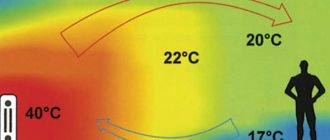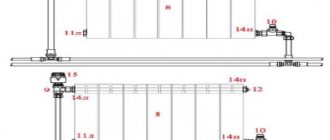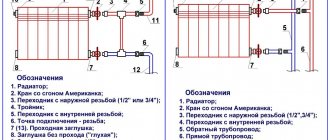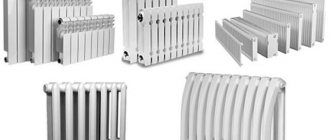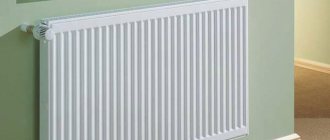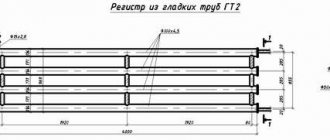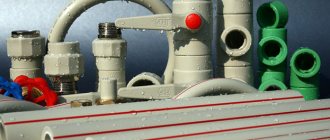Design work on the creation of heating systems requires a clear understanding of the dimensions of heating elements, including radiators. Considering the significant diversity of the latter, such systematization is a truly important task. There are three large groups of radiator sizes:
- standard for the former USSR;
- low radiators;
- tall and non-standard.
Based on the type of materials, radiators are classified as follows:
- aluminum;
- cast iron;
- steel;
- bimetal
Aluminum battery sizes
In Soviet times, “winged metal” was almost not used in the production of metal structures and household appliances due to its shortage; aluminum radiators appeared only in the 90s. Therefore, they are characterized by a wide variety of sizes. The most common sizes: 80x100x585 mm.
Heat dissipation is up to 200 watts per radiator section. The operating pressure of the coolant in the system is 16 atmospheres. Low aluminum radiators are available in a wide range of sizes: from 150 to 400 mm. The most common are 40x200x180 mm.
As you can see, the short length and height of the section is compensated by its high depth, which is almost twice as high as on Soviet standard radiators. This allows “low” format radiators to have very variable heat output - from 50 to 180 Watts per section. Working pressure - 16-24 atm.
What sizes are aluminum radiators?
Dimensions are one of the main criteria for choosing aluminum batteries. This is because correctly selected dimensions of aluminum radiators directly affect heating efficiency, as well as the need to make changes in the pipes through which the coolant flows. For example, if the center-to-center distance of the product is different from the same indicator of the previously used heating device, then the position of at least one horizontal pipe will have to be changed.
What should the dimensions be?
In order for the heating radiator to give off maximum heat (in this case we are not talking about its thermal power, but about the efficiency of its operation), the dimensions must be as follows:
- The length should be more than 70-75% of the width of the window opening.
- The height should be such that there is 8-12 cm between the floor and the battery, and 6-12 cm between the window sill and it.
If the recommendations are not followed, the operation of the aluminum radiator will be accompanied by heat loss. Therefore, even if he can provide the necessary for a room with an area of 20 square meters. m 200 watts of heat, then due to incorrect dimensions there will be insufficient heat in the room. After all, part of it may be lost under the windowsill or used to heat the floor.
When the length is less than 70% of the width of the window opening, the battery will not be able to create a thermal curtain capable of blocking the movement of cold air entering through the window. The consequence of this situation will be the appearance of cold and warm zones in the room. Also, the windows will be constantly covered with steam. And even the power of the heating radiator, which is greater than the need, cannot become a “magic wand”.
Therefore, if the window has a width of 2 m, then the length of the battery should be at least 1.4 m. Of course, in order to select a device with such a length, you will need to take into account the sections of different heights and their heat transfer. The calculation may take a long time, but it is worth it.
Main dimensions
Dimensions mean:
- Center distance.
- Height.
- Depth.
- Section width.
The center-to-center distance (also called inter-nipple or center-to-center) should not be confused with the height of the heating radiator. The first indicator indicates how many centimeters are between the upper and lower collectors (holes). Height is the distance between the lowest and highest point of the section.
Aluminum heating radiators have the following dimensions:
- The center distance ranges from 150 to 2,000 mm. Very tall radiators are rare. The most popular are radiators with an inter-nipple distance of 500 mm. This is because the current heating network pipe system was created for cast iron batteries, which have the same center-to-center distance. Since many owners did not and do not have the desire to digest pipes, they simply selected/are selecting a suitable radiator and, thereby, increased the popularity of a battery with an interaxial distance of 0.5 cm. This indicator is very important, and therefore manufacturers indicate it in the name of the battery (RAP-500, Rococo 790, Magica 400, etc.).
- The height is in the range of 245-2000 mm. According to this criterion, batteries can be divided into low, medium and high. The features of each type will be discussed below.
- The section depth ranges from 52 to 180 mm. Some models may have greater depth, however, this is rare.
- The section width is 40-80 mm.
Low aluminum radiators
Such devices for heating a room have a height from 200 to 450-500 mm. The lowest representatives have an interaxal distance of 150 mm. The smallest section width is 40 mm. As for depth, this characteristic differs significantly from options with medium and high heights. Sometimes it can reach 0.18 cm. Of course, this is done to compensate for the lack of thermal power due to the low height.
It is worth saying that few manufacturers produce radiators with an interaxial distance of 150-250 mm. The main ones are Sira, Global, Rifara. The smallest products of the first have a height of 245 mm. The inter-nipple distance is 200 mm. The depth depends on the model. Thus, Alux has a depth of 8 cm, and Rovall – 10 cm. The smallest radiators of the other two manufacturers have almost the same dimensions.
If we consider heating radiators with an interaxial distance of 300 mm or more, then almost all companies produce them.
Standard or Medium Batteries
Their features are:
- Height - 0.57-0.585 cm.
- The most common width is 80 mm. Very rarely a section has a different width.
- Depth 52-100 mm. Standard sizes in this regard are considered to be 80-100 mm.
- The center distance is 500 mm.
Medium-height aluminum heating radiators can be called the most standardized among all types of batteries. For comparison, the fluctuations in height and depth of cast iron heating devices are much greater. So, the depth only varies between 90-140 mm.
Tall as well as flat batteries
Only extrusion radiators can have a height of up to 2-2,050 m. There are no cast ones higher than standard indicators. Often tall products have shallow depth and small width.
As for flat heating devices, they are also represented by a small number of models. They are mainly produced by Zlatoust Termal. A special feature of flat radiators is that their depth is 52 mm regardless of height. Models RAP300 and RAP500 always have this depth.
It seems that shallow depth results in a significant reduction in thermal output. However, this figure for both models is 105 W and 161 W, respectively. As you can see, he is quite good.
(2 votes, rating: 5.00 out of 5)
poluchi-teplo.ru
Dimensions of bimetallic batteries
Bimetallic radiators consist of a steel core and an aluminum body. The main change that a steel core brings compared to an aluminum one is an increase in the permissible coolant pressure. Of course, the price also increases. The most common sizes: 80-82x75-100x550-580 mm.
Heat transfer is slightly reduced due to the lower thermal conductivity of steel, but is compensated by greater ribbing in the section area. Heat transfer rates: 160-200 Watts per section. The working pressure can be significantly yours: from 25 to 50 atmospheres.
Bimetallic radiators are characterized by the same range of standard sizes as aluminum ones.
The dimensions of low aluminum radiators are also typical for bimetallic ones. At the same time, the heat transfer characteristics also change slightly: radiators from 40 to 140 watts per section are common.
Bimetallic radiators, due to their higher performance characteristics, are more often used to build non-standard heating systems. In particular, such radiators are often used to stylize heating elements in the form of interior design elements.
It simply doesn’t make sense to somehow evaluate standard sizes - they simply don’t exist. Most European radiator manufacturers have their own series of radiators in a wide variety of, often exotic, sizes.
Dimensions of cast iron radiators
The standard cast iron radiator of the MS-140-500-0.9 brand is a long-liver of Soviet “Khrushchev” apartments and panels. It was this model that was most often used in the USSR to equip collective heating systems. Its characteristics: 93x140x588 mm.
Most often, such radiators are 7-10 sections long. Heat dissipation - 160 Watt. The operating pressure of the coolant is 9 atmospheres.
Cast iron radiators, sized for low ceilings, are represented by the Belarusian model MS-140M-300-0.9. Specifications: 93x388x140 mm. The heat output is 106 watts. The operating pressure of the coolant has not changed. There are imported samples with center distances of 150, 200 and even 350 mm, but these are clearly exotic.
Large cast iron radiators are represented almost exclusively by imported, European models. For example, consider the characteristic Demrad Retro line: 76x661-954x203 mm.
Working pressure - 10 atmospheres. Thermal power is impressive: 270 Watts per section. There are also more exclusive models on the market. However, they are used extremely rarely, primarily due to the large weight of the cast iron structure.
Heating radiator sizes
The standard height of the most popular models of heating devices with the center distance along the connections is 500 millimeters.
These are the batteries that in most cases could be seen about two decades ago in city apartments. Cast iron radiators
. A typical representative of these devices is model MS-140-500-0.9.
The specifications for it include the following overall dimensions of cast iron heating radiators:
- the length of one section is 93 millimeters;
- depth - 140 millimeters;
- height – 588 millimeters.
Calculating the dimensions of a radiator from several sections is not difficult.
When the battery consists of 7-10 sections, add 1 centimeter, taking into account the thickness of the paronite gaskets. If the heating battery is to be installed in a niche, it is necessary to take into account the length of the flushing tap, since cast iron radiators with side connections always require flushing. One section provides a heat flow of 160 watts at a temperature difference between the hot coolant and the air in the room of 70 degrees. The maximum working pressure is 9 atmospheres. Aluminum radiators
. For aluminum heating devices on the market today, with the same center-to-center spacing of the connections, there is a significant variation in parameters (for more details: “Dimensions of aluminum heating radiators, section volume, preliminary calculations”).
Typical sizes of aluminum heating radiators are:
- the length of one section is 80 millimeters;
- depth 80-100 millimeters;
- height - 575-585 millimeters.
The heat transfer of one section directly depends on the area of its fins and depth. Typically it ranges from 180 to 200 watts. The operating pressure for most models of aluminum batteries is 16 atmospheres. Heating devices are tested with one and a half times higher pressure - this is 24 kgf/cm².
Aluminum radiators have the following feature: the volume of coolant in them is 3 and sometimes 5 times less than in cast iron products. As a result, the high speed of movement of hot water prevents silting and the formation of deposits.
Bimetallic radiators
. The steel core in such devices does not in any way affect their appearance and the size of the heating radiators, but the maximum operating pressure increases significantly. Unfortunately, the increased strength of the bimetallic battery leads to high costs. And the price of such a product is already inaccessible to a wide range of consumers.
Bimetallic heating radiators have the following section dimensions:
- length 80-82 millimeters;
- depth - from 75 to 100 millimeters;
- height – minimum 550 and maximum 580 millimeters.
In terms of heat transfer, one bimetallic section is inferior to an aluminum section by about 10-20 watts. The average heat flux is 160-200 watts. Due to the presence of steel, the operating pressure reaches 25-35 atmospheres, and during testing - 30-50 atmospheres.
When arranging a heating structure, you should use pipes that are not inferior in strength to radiators. Otherwise, using durable devices loses all meaning. For bimetallic radiators, only steel liner is used.
Dimensions of steel radiators
In the USSR, heating radiators were traditionally made from cast iron. Consumer fashion for aluminum, bimetallic and steel radiators appeared relatively recently. Therefore, among these products the most common are products from European manufacturers. Accordingly, such radiators have a European system for classifying dimensions and sizes:
- Type 10 – one row, no fins, like cladding;
- 11 – one row with fins, without cladding;
- 20 – two rows without fins;
- 21 – two rows with fins, cladding and grille;
- 22 – two rows with two fins, panel cladding and grille;
- 30 – three rows without fins and with an upper grille;
- 33 – three rows with three panels and an upper grille.
Currently, the most common radiators are types 11, 22 and 33. These radiators have the following dimensions:
- 11— 30x40 cm;
- 11— 90x40 cm
- 22—50x100 cm
- 22— 90x300 cm
- 33— 30x100 cm
- 33—60x100 cm.
How to calculate the size of radiators for a room
Knowing the basic characteristics of heating equipment and the area of the room, you can easily determine the required radiator power, and subsequently all the characteristics of the system, including the boiler.
Let's look at a similar calculation using a real example:
Let’s say a room with the characteristics of 4x3x2.7 is planned for installation of heating - a standard bedroom in a Soviet Khrushchev-era building.
First, let's calculate the volume of the room that will have to be heated: 4*3*2.7=32.4 m3. It is this volume of air that our radiator will have to heat.
Then you should determine how much heat will need to be spent to heat this volume. Without taking into account measures to increase energy efficiency (energy saving, wall insulation, etc.), the standard for the temperate climate zone of Eastern Europe is the cost of heating one cubic meter of 41 watts.
Accordingly, to heat our room you will need: 32.4 m3 * 31 Watt = 1.3 kV
This is the amount of energy that the air needs to receive from the radiator for heating. Next, knowing the required amount of heat, you can calculate the technical characteristics of the radiator that will be mounted.
Each radiator has a heat transfer characteristic. This is the amount of energy that the equipment is capable of releasing into the atmosphere while maintaining the quality indicators of the heating system. This figure may be underestimated, but cannot be exceeded. The radiator power is always indicated on the packaging, in the passport or certificate.
Heating our room will require 1.3 kW of energy. To prevent force majeure effects during abnormal frosts, the indicator is calculated with a margin of 15-20%. In total we have 1.5 watts.
One fin of a standard bimetallic radiator is capable of delivering up to 150-180 Watts of energy. Total: 1500/150=10. Those. To fully heat our room, we will need to install a 1.5 kW radiator, consisting of 10 fins.
Important! The Soviet heating standard was used in the calculations. In practice today, most older apartment buildings and new buildings under construction use numerous technologies to improve energy efficiency. For the most accurate calculation, you should better study the thermal efficiency indicators of the house, windows, etc.
If the walls are insulated and vacuum metal-plastic windows are installed, the actual energy consumption for heating can be reduced by 2 or more times. Accordingly, there is no point in purchasing a radiator of higher power.
How tall are aluminum radiators?
The actual height of the heating radiator often does not correspond to that indicated in the specifications, instructions or data sheet. The fact is that manufacturers usually indicate the center-to-center distance between the centers of horizontal channels (see figure).
Height of the heating radiator and center distance.
It is important to know the center-to-center distance in order to design the location and installation of pipes. The actual height of an aluminum radiator is important when you are going to install it in a niche or under a window. In this case, it is necessary to take into account the height tolerances at the top and bottom. Read more about this in the article on the correct installation of heating radiators.
There are several standard center distance options for aluminum radiators:
- 30-35 cm;
- 50-55 cm;
- 60 cm;
- 90 cm.
The height of the section of an aluminum heating radiator may be 7-15 cm larger, depending on the design, manufacturer, etc. In addition, some models may have a non-standard center-to-axle distance, for example, 58.5 cm. But to determine which option is needed, approximate values will be enough.
